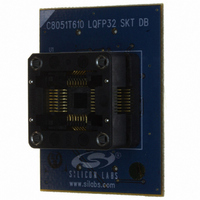C8051T610DB32 Silicon Laboratories Inc, C8051T610DB32 Datasheet - Page 172

C8051T610DB32
Manufacturer Part Number
C8051T610DB32
Description
DAUGHT BOARD T610 32TQFP SOCKET
Manufacturer
Silicon Laboratories Inc
Datasheet
1.C8051T610DB32.pdf
(218 pages)
Specifications of C8051T610DB32
Module/board Type
Socket Module - TQFP
Processor To Be Evaluated
C8051T61x
Interface Type
USB
Lead Free Status / RoHS Status
Lead free / RoHS Compliant
For Use With/related Products
C8051T610DK
Lead Free Status / RoHS Status
Lead free / RoHS Compliant, Lead free / RoHS Compliant
Other names
336-1505
- Current page: 172 of 218
- Download datasheet (2Mb)
C8051T610/1/2/3/4/5/6/7
25.1. Timer 0 and Timer 1
Each timer is implemented as a 16-bit register accessed as two separate bytes: a low byte (TL0 or TL1)
and a high byte (TH0 or TH1). The Counter/Timer Control register (TCON) is used to enable Timer 0 and
Timer 1 as well as indicate status. Timer 0 interrupts can be enabled by setting the ET0 bit in the IE regis-
ter (Section “16.2. Interrupt Register Descriptions” on page 87); Timer 1 interrupts can be enabled by set-
ting the ET1 bit in the IE register (Section “16.2. Interrupt Register Descriptions” on page 87). Both
counter/timers operate in one of four primary modes selected by setting the Mode Select bits T1M1–T0M0
in the Counter/Timer Mode register (TMOD). Each timer can be configured independently. Each operating
mode is described below.
25.1.1. Mode 0: 13-bit Counter/Timer
Timer 0 and Timer 1 operate as 13-bit counter/timers in Mode 0. The following describes the configuration
and operation of Timer 0. However, both timers operate identically, and Timer 1 is configured in the same
manner as described for Timer 0.
The TH0 register holds the eight MSBs of the 13-bit counter/timer. TL0 holds the five LSBs in bit positions
TL0.4–TL0.0. The three upper bits of TL0 (TL0.7–TL0.5) are indeterminate and should be masked out or
ignored when reading. As the 13-bit timer register increments and overflows from 0x1FFF (all ones) to
0x0000, the timer overflow flag TF0 in TCON is set and an interrupt will occur if Timer 0 interrupts are
enabled.
The C/T0 bit in the TMOD register selects the counter/timer's clock source. When C/T0 is set to logic 1,
high-to-low transitions at the selected Timer 0 input pin (T0) increment the timer register (Refer to Section
“21.3. Priority Crossbar Decoder” on page 117 for information on selecting and configuring external I/O
pins). Clearing C/T selects the clock defined by the T0M bit in register CKCON. When T0M is set, Timer 0
is clocked by the system clock. When T0M is cleared, Timer 0 is clocked by the source selected by the
Clock Scale bits in CKCON (see SFR Definition 25.1).
Setting the TR0 bit (TCON.4) enables the timer when either GATE0 in the TMOD register is logic 0 or the
input signal INT0 is active as defined by bit IN0PL in register IT01CF (see SFR Definition 16.5). Setting
GATE0 to 1 allows the timer to be controlled by the external input signal INT0 (see Section “16.2. Interrupt
Register Descriptions” on page 87), facilitating pulse width measurements
Setting TR0 does not force the timer to reset. The timer registers should be loaded with the desired initial
value before the timer is enabled.
TL1 and TH1 form the 13-bit register for Timer 1 in the same manner as described above for TL0 and TH0.
Timer 1 is configured and controlled using the relevant TCON and TMOD bits just as with Timer 0. The
input signal INT0 is used with Timer 1; the /INT1 polarity is defined by bit IN1PL in register IT01CF (see
SFR Definition 16.5).
172
Note: X = Don't Care
TR0
0
1
1
1
GATE0
X
0
1
1
Rev 1.0
INT0
X
X
0
1
Counter/Timer
Disabled
Disabled
Enabled
Enabled
Related parts for C8051T610DB32
Image
Part Number
Description
Manufacturer
Datasheet
Request
R
Part Number:
Description:
SMD/C°/SINGLE-ENDED OUTPUT SILICON OSCILLATOR
Manufacturer:
Silicon Laboratories Inc
Part Number:
Description:
Manufacturer:
Silicon Laboratories Inc
Datasheet:
Part Number:
Description:
N/A N/A/SI4010 AES KEYFOB DEMO WITH LCD RX
Manufacturer:
Silicon Laboratories Inc
Datasheet:
Part Number:
Description:
N/A N/A/SI4010 SIMPLIFIED KEY FOB DEMO WITH LED RX
Manufacturer:
Silicon Laboratories Inc
Datasheet:
Part Number:
Description:
N/A/-40 TO 85 OC/EZLINK MODULE; F930/4432 HIGH BAND (REV E/B1)
Manufacturer:
Silicon Laboratories Inc
Part Number:
Description:
EZLink Module; F930/4432 Low Band (rev e/B1)
Manufacturer:
Silicon Laboratories Inc
Part Number:
Description:
I°/4460 10 DBM RADIO TEST CARD 434 MHZ
Manufacturer:
Silicon Laboratories Inc
Part Number:
Description:
I°/4461 14 DBM RADIO TEST CARD 868 MHZ
Manufacturer:
Silicon Laboratories Inc
Part Number:
Description:
I°/4463 20 DBM RFSWITCH RADIO TEST CARD 460 MHZ
Manufacturer:
Silicon Laboratories Inc
Part Number:
Description:
I°/4463 20 DBM RADIO TEST CARD 868 MHZ
Manufacturer:
Silicon Laboratories Inc
Part Number:
Description:
I°/4463 27 DBM RADIO TEST CARD 868 MHZ
Manufacturer:
Silicon Laboratories Inc
Part Number:
Description:
I°/4463 SKYWORKS 30 DBM RADIO TEST CARD 915 MHZ
Manufacturer:
Silicon Laboratories Inc
Part Number:
Description:
N/A N/A/-40 TO 85 OC/4463 RFMD 30 DBM RADIO TEST CARD 915 MHZ
Manufacturer:
Silicon Laboratories Inc
Part Number:
Description:
I°/4463 20 DBM RADIO TEST CARD 169 MHZ
Manufacturer:
Silicon Laboratories Inc










